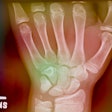Shutting down angiography imaging systems after 15 minutes of idle time has the potential to save nearly half of the system’s annual energy consumption, according to a study presented December 5 at the RSNA meeting in Chicago.
The finding is from a study at Ulm University Medical Center in Ulm, Germany, and highlights an effective strategy for mitigating the environmental impact of angio systems in interventional radiology (IR) departments, noted presenter Billurvan Taskin, MD, and colleagues.
“Strategies to reduce energy consumption through imaging modalities in healthcare are an essential topic in the era of climate and energy crises,” the group wrote.
Angiography imaging systems have the second highest energetic impact behind MRI scanners, according to the researchers. Real-world measurements of angiography systems are largely lacking, however, as are extrapolations regarding reducing idle times and/or smart use of biplane systems, the group noted.
To address this gap in knowledge, the researchers collected data from RIS log files and PACS reports from a biplane angiography system (Azurion 7 B20, Philips) over a six-weeks period. The researchers recorded times for procedures, standby, and turn-off periods, as well as the number and type of procedures, energy used (in kilowatt-hours), and power (in Watts). Standby periods were subdivided into periods longer than 30, 60, and 120 minutes.
The system was used in real biplane and sole monoplane mode, with extrapolated values calculated for energy consumption to quantify the expectable yearly effects of three different energy reduction approaches.
According to the findings, the system was on stand-by for 17% of the time over the period, in procedures for 10%, and turned off for 72% of the period. The average power usage was slightly lower in standby mode than during ongoing procedures (4.44 kW versus 4.98 kW, p < 0.001), they found.
In the off state, power usage was remarkably low at 0.24 kW, the group noted. Also, 82% of the standby periods were longer than 60 minutes, and thus, shutting down the system after 15 minutes of idle time has the potential to save 43% or 5464 kWh of annual energy, the researchers calculated.
Moreover, an option for selected procedures -- using the genuine biplane system as a monoplane system (which requires switching off the second tube) -- would result in a further reduction in energy consumption of 5.3%, or 681 kWh in a full year, the group noted.
“The largest portion of the consumed energy of a biplane system is used for long standby periods since power usage is only slightly lower in standby than during an ongoing procedure,” the researchers wrote.
Ultimately, imaging modalities in IR consume significant amounts of energy and optimization is virtually mandatory in these times of climate and energy crises, the researchers suggested.
“Reduction of idle times and smart use of biplane systems can have a major impact,” the group concluded.
For our full coverage of this year’s meeting, visit our RADCast.



















